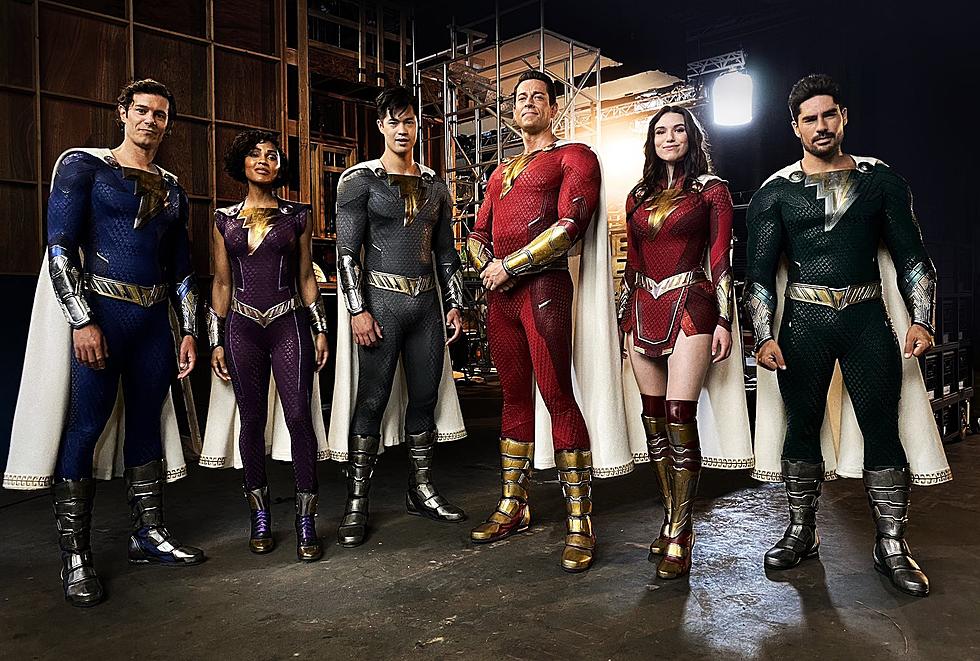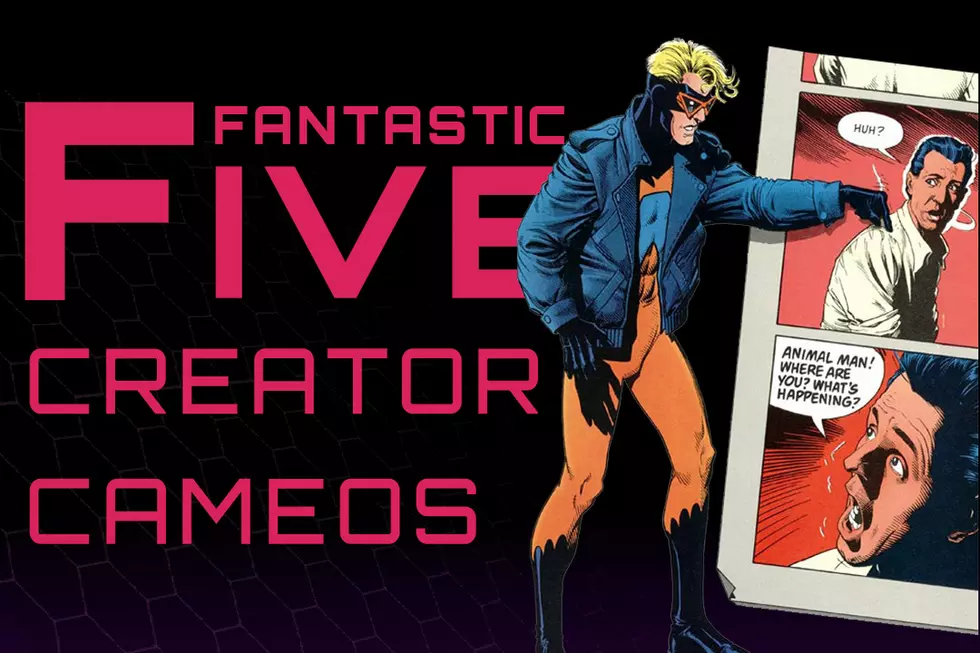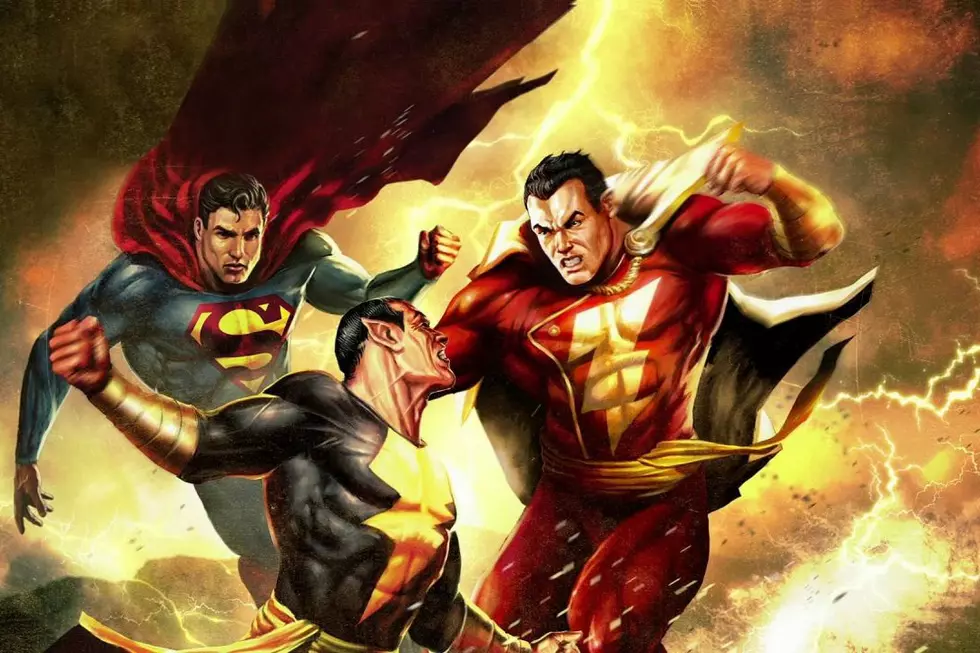![Vampire Batman, Hypnotic Induction, And God: Grant Morrison Talks ‘The Multiversity’ [Interview]](http://townsquare.media/site/622/files/2014/07/Multiversity-map_1400x1074-1-630x483.jpg?w=980&q=75)
Vampire Batman, Hypnotic Induction, And God: Grant Morrison Talks ‘The Multiversity’ [Interview]
For years now, DC Comics fans have been hearing about writer Grant Morrison's The Multiversity -- a universe-jumping series of one-shot stories tied together by an introductory and concluding issue that tracks the cosmic monitor Nix Woton as he tries to save multiple universes from an existential threat. Universes that become aware of this threat by reading about it in comic books... comic books that, it turns out, take place in neighboring universes. We first saw artwork from Frank Quitely's installment all the way back in 2012, but the project has been in the works since even before the advent of DC's line-wide 2011 reboot, the New 52 (a name that has proven confusing in the past, but, we promise, never more so than in this interview).
Now it's finally starting next month, featuring auspicious collaborations with artists including Cameron Stewart, Ben Oliver, Chris Sprouse, Ivan Reis, Frank Quitely, and even more besides, introducing readers to a Vampire Batman, a Nazi Superman, a dinosaur cop, "Sister Miracle," an evil comic book called Ultra Comics, and tons of other ideas inspired by the deep history of DC Comics lore.
Some of that lore actually comes from other companies, of course, and those elements will be prominently represented in Multiversity. The Shazam family of characters originated in the Fawcett Comics titles of the 1940s, and take a prominent role in Multiversity's "Thunderworld" issue drawn by Cameron Stewart. Likewise, the heroes acquired by DC from Charlton Comics -- such as the Question and Blue Beetle -- star in their own issue with artwork by Frank Quitely, who with Morrison will place the characters into a story and style reminiscent of Watchmen, the Alan Moore and Dave Gibbons graphic novel inspired by the same characters.
If that's not deep enough for you, maybe you'd prefer the Chris Sprouse-drawn world of Earth 20, the home of DC's World War II era heroes like Doctor Fate (or "Doc Fate", as he's known in Multiversity) and Lady Blackhawk. There's also Earth 16, drawn by Ben Oliver, where the descendants of Superman and the rest of the greatest DC heroes have become vapid, grotesque celebrities like something out of reality television.
But those are just a few details of what will be seven much more fleshed out universes, but even those are just seven of 52. There's a lot to keep track of, so in addition to Multiversity itself, DC and Morrison will release a guidebook that will finally -- seven years since it was introduced in 52 -- break down and explain the DC multiverse. Somehow fittingly, the book will feature Jack Kirby's Kamandi, the last boy on Earth, and include a multiversal map designed by Rian Hughes showing where each of DC's 52 universes lies on a cosmic landscape.
From what we can see, the Monitor Sphere and the Sphere Of The Gods oversee all of creation, with perhaps lesser entities residing in realms identified as Apokalips, Nightmare, Hell, Underworld, Dream, Heaven, New Genesis, or Skyland. All the universes are contained in an "Orrery of Worlds," a concept you may remember from 52, the series Morrison wrote with Geoff Johns, Mark Waid and Greg Rucka that excavated the multiverse from DC's continuity basement.
We sat down with Morrison at Comic-Con International in San Diego for a few minutes to dig into all these events and ideas and talk about how The Multiversity has evolved over its long production.

ComicsAlliance: The Multiversity is a comic book story that's been years in the making. I'd be interested to start with how, in your mind, the shape of Multiversity has changed in the eight years since we've first heard about it.
Grant Morrison: Well originally came out with what we were doing in 52, back in the day with Geoff and Mark and Greg. Originally it was going to be related to that, and as you've seen lots of things happened in the end to them. I was pretty busy. The story took a long time to put together and we had to create fifty new universes. It's been a long time, and also, we've been waiting for artists. The artists are very good in this book and it's just taken people quite a long time. So over that time, the DC Universe has changed quite considerably, which is why I left the guide book to the very end so I could kind of tie it in. So everything is updated along with the New 52, and I think the fact that they called it New 52 makes this book more appropriate now because it kind of serves as an expansion of that universe rather than something different.
CA: You talked about having to create new universes for Multiversity. In the time since this was first conceived, it was part of 52, or came out of 52, now Multiversity accounts for the New 52. Did you have to change much about the the concepts and characters you had "cast" in Multiversity, or the conceptions of the universes where you're placing these characters?
GM: There wasn't an awful lot of drastic changes, honestly. Because the multiverse is kind of side by side with the DC Universe as it is. A lot of the things didn't have to change much. The version of, say, the Charlton characters didn't have much to do with what was going on in the New 52 anyway, so there wasn't a lot of changes there. Generally what I've done with most of these Earths -- especially the ones where Superman and Batman are quite similar; like he's a Nazi Superman or he's a Nazi Batman or the Vampire Batman.... all we tried to do there was... sorry I lost my thread thinking about Vampire Batman. What was your question?
CA: Vampire Batman is a very distracting concept.
GM: It's very easy to get caught up in just thinking about Vampire Batman.
GM: But the idea was that all the characters reflected the changes in the New 52. So when you see Vampire Batman, for instance, he'll look a bit more generally like designed Batman of the current DC Universe. So, stylistically we tried to keep on top of and obviously very aware of what's happening with Darkseid and the build up that's going on in Justice League. So we kind of touch on that. But as I said, because it takes place outside the New 52, we didn't have to do an awful lot of twisting and turning to just keep pace with that.
CA: The last time you did a series that had this structure to it was Seven Soldiers. Seven concurrent stories with starting and ending chapters. That ended up having a huge effect on DC, as it stood then. A lot of those characters endured. Frankenstein is still around. What kind of impact do you see Multiversity having on the New 52, the DC Universe as it stands now? You talked about it this project being a little separate from it, but I can't imagine that there won't be some lasting impact as well.
GM: I'd like to hope so, obviously. Part of designing all these worlds, the idea was that there isn't a single Earth in there that couldn't sustain its own book. One of the things I disliked about people using the multiverse before was that they were creating things indiscriminately. If someone wanted a bad Superman, they'd just pull one from Earth X and suddenly you have a bad Superman and you kill him at the end of the story and never refer to that world again. I thought that was slightly wasteful. Every world should be capable of sustaining its own series and its own stories. So that's what we've done with it.
Unlike Seven Soldiers... that was a lot more modular. This one is more of relay race, that was the structure we built because each universe is reading the comic books from the previous universe, and that's how they learn about the threat, basically. It's more like a chain. It doesn't have the same intricate jigsaw pattern as Seven Soldiers. It's quite linear, this one. I wanted to do something quite linear and simple and everyone could "get" this time. This one is for people who've never read DC before but want to get into this gigantic maelstrom of characters and versions of characters; the prismatic world of DC.
CA: They call it the "prismatic age."
GM: Yeah!
CA: As we're getting into that more philosophical stuff, in Supergods you talk about the power of stories and superheros being inspirational figures and aspirational figures. That seems like that concept very much plays into Multiversity as comics are part of the universe and how these characters learn about each other. But at the same time, there's a malevolent comic book in play.
GM: Oh yeah, very much. There's got to be a bad guy somewhere. I don't want to say too much about that, but certainly the thing that we're doing, which is the seventh issue of the series, it's called "Ultra Comics", and it's kind of a new character but it's based on Earth Prime, which is our Earth, which we re-named Earth 33 now just so it fits in the numerical structure. So Earth Prime is here and I thought, in the past there had been stories like the evil Superboy who lives here. Geoff Johns wrote this guy who sits in his basement writing at the comic news sites [Editor's note: Superboy-Prime is the best comic book character ever]. Prior to that we've had stories where the Flash would meet up with Julie Schwartz, the Flash editor, or Cary Bates, the writer.
So I'm thinking, well, we know there are no superheroes in this world; there just are none. What does a superhero look like in this world? Well, it's made of paper, or it's something that appears in celluloid. So I set up the task of making the world's first superhero and the comic being that. I'm interested in the idea of religions of "the book", that we have in this world. The way they thrive is an actual book, which is the god. It's not just the word of god, the book itself is God. So people take instruction from it and it becomes a programming language that's easy to go back and refer to like a manual. So I kind of wanted to do what with a superhero comic.
And you'll see how it works. I've used a lot of hypnotic induction. There's an old trick that Stan Lee used to do -- it was quite popular at Marvel -- of the comic talking to you. I took that and this thing, and I think we've actually created the world's first actual superhuman being, which you'll see how it works when you read this comic. Then the world's first super human being on this earth has to fight the most malignant entity. So the bad guys in Multiversity who are attacking the entire multiversal structure are also attacking the real world, and this comic is their only way through right now. So it becomes the reader versus the bad guy on the page. I think it's actually quite scary, this thing. It scared me!
CA: We've been getting into the deep philosophical stuff about this series, but if someone is trying to work their way into getting into DC Comics, what's going to appeal to them about Multiversity?
GM: The stories are good. The art is brilliant. The basic comic book stuff is all solid. The most interesting stuff for me, and what I loved as a kid, was just the variance and the versions. I think there's just something always appealing about Vampire Batman or President Superman, these little iterations of characters, and I think thats mostly what it's all about. That's where the real fun lies, in creating the spectrum of how far can you get it from the core before it disintegrates? I think that in itself is just always appealing. There's more color. There's more powers. There's more Earths. So if you like all that stuff in the first place, this is like more of everything. The ultimate banquet of that.
CA: Bigger and better.
GM: Yeah, it's my ultimate big old statement. I've gone so far out there, I've hit the white wall. So I think this is my ultimate statement of what DC is.
The Multiversity #1 goes on sale in August from DC Comics.
More From ComicsAlliance

![Five Stars: Starting At The End With Jeff Smith [Interview]](http://townsquare.media/site/622/files/2017/03/FiveStars-Smith.jpg?w=980&q=75)







